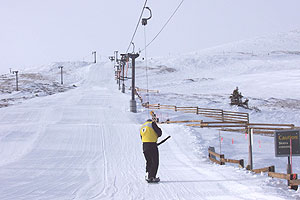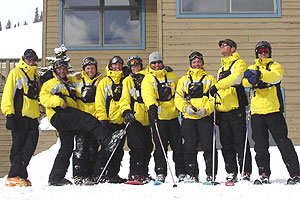Safety Tips
At Breckenridge, safety comes first for all of
our guests and employees. The resort has put in
place programs that promote the safety of everyone
on the mountain as well as educate our guests on the
importance of snowsports safety.

SKI SAFETY:
HEADS UP- KNOW THE CODE, IT'S YOUR
RESPONSIBILITY
YOUR RESPONSIBILITY CODE:
Breckenridge is committed to promoting skier safety.
In addition to people using traditional alpine ski
equipment, you may be joined on the slopes by
snowboarders, telemark skiers or cross-country
skiers, skiers with disabilities, skiers with
specialized equipment and others. Always show
courtesy to others and be aware that there are
elements of risk in skiing and snowboarding that
common sense and personal awareness can help reduce.
Know your ability level and stay within it. Observe
“Your Responsibility Code” listed below and share
with other skiers the responsibility for a great
skiing experience.
1. Always stay in control, and be able to stop or
avoid other people or objects.
2. People ahead of you have the right of way. It is
your responsibility to avoid them.
3. You must not stop where you obstruct a trail or
are not visible from above.
4. Whenever starting downhill or merging into a
trail, look uphill and yield to others.
5. Always use devices to help prevent runaway
equipment.
6. Observe all posted signs and warnings. Keep off
closed trails and out of closed areas.
7. Prior to using any lift, you must have the
knowledge and ability to load, ride and unload
safely.
Be advised that Breckenridge Ski Resort does not
mark all potential obstacles or hazards. When
marked, poles, flags, fencing, signage, padding or
other forms of marking are used to inform the
skier/rider of the location of a potential obstacle
or hazard. These markers are no guarantee of your
safety. It is part of your responsibility under the
Your Responsibility Code and the Colorado Ski Safety
Act to avoid all obstacles and hazards.
COLORADO SKI SAFETY ACT
The Colorado legislature, recognizing risks
that are inherent in the sport, has passed the
Colorado Ski Safety Act which
provides inherent risks of the sport and relative
responsibilities of the skier; and the ski area. You
must obey the Act. Under the Act, any person using
the facilities of a ski area is considered a skier.
A summary of the inherent risks is listed below:
WARNING
Under Colorado law, a skier assumes the risk of any
injury to person or property resulting from any of
the inherent dangers and risks of skiing and may not
recover from any ski area operator for any injury
resulting from any of the inherent dangers and risks
of skiing, including: changing weather conditions;
existing and changing snow conditions; bare spots;
rocks; stumps; trees; collisions with natural
objects, man-made objects, or other skiers;
variations in terrain; and the failure of skiers to
ski within their own abilities.
The Ski Safety Act was amended in 2004 to include
CLIFFS, EXTREME TERRAIN, JUMPS AND FREESTYLE TERRAIN
as inherent dangers and risks of the sport.
Skiers and Riders should be advised that a
green circle, blue square, or black diamond trail at
Breckenridge Ski Resort is not necessarily the same
as a green circle, blue square or black diamond
trail at other resorts. The system is a relative
rating of trails at each resort and does not compare
trail difficulty between resorts. Skiers and Riders
should begin with the easiest terrain and then move
up in difficulty as their ability permits in order
to understand the relative rating at Breckenridge
Ski Resort.
EXTREME TERRAIN
contains cliffs, very steep slopes as well as rocks
and other hazards. Skiing or boarding Extreme
Terrain is for EXPERTS ONLY.

EXTREME TERRAIN
FREESTYLE TERRAIN AREASare designated with
an orange oval and may contain jumps, hits, ramps,
banks, fun boxes, jibs, rails, half pipes, quarter
pipes, snowcross, bump terrain and other constructed
or natural terrain features. Prior to using
Freestyle Terrain, you are responsible for
familiarizing yourself with Freestyle Terrain and
obeying all instructions, warnings and signs.
Freestyle skills require maintaining control on the
ground and in the air. Use of Freestyle Terrain
exposes you to the risk of serious injury or death.
Inverted aerials are not recommended. You assume the
risk.

Free Style Terrain
Freestyle Terrain has designations for size. Start
small and work your way up. Designations are
relative to this ski area.

Smaller Features Medium
Features Larger Features
MAKE A PLAN. Every time you use
Freestyle Terrain, make a plan for each feature you
want to use. Your speed, approach and takeoff will
directly affect your maneuver and landing.
LOOK BEFORE YOU LEAP. You are
responsible for inspecting Freestyle Terrain before
initial use and throughout the day. The features
vary in size and change constantly due to snow
conditions, weather, usage, grooming and time of
day. Do not jump blindly. Use a spotter when
necessary.
EASY STYLE IT.Always ride or ski in
control and within your ability level. Do not
attempt Freestyle Terrain unless you have sufficient
ability and experience to do so safely. You control
the degree of difficulty you will encounter in using
Freestyle Terrain, both on the ground and in the
air.
RESPECT GETS RESPECT. Respect
Freestyle Terrain and others. Only one person on a
feature at a time. Wait your turn and call your
start. Always clear the landing area quickly.
Respect all signs and do not enter Freestyle Terrain
or use features when closed.
ELECTRONIC DEVICES. Vail Resorts
strongly discourages the use of electronic devices
including cell phones, personal entertainment and
communication devices, and any other electronic
equipment that utilizes head/ear phones while skiing
and snowboarding, or loading and unloading lifts.
LIFT SAFETY. Under
Colorado law, you cannot board a lift unless you
have sufficient physical dexterity, ability and
knowledge to negotiate or to use such lift safely,
or until you have asked for and received information
sufficient to enable you to use the lift safely. You
may not use a lift or any ski trail when under the
influence of drugs or alcohol.
CAUTION.Snowcats, snowmobiles and
snowmaking may be encountered at any time.
SLOW ZONES. Certain areas
(indicated on the map in yellow) are designated as
SLOW ZONES. Please observe the posted slow areas by
maintaining a speed no faster than the general flow
of traffic. Space and speed are especially important
in these areas. Fast and aggressive skiing will not
be tolerated.
HELMET USE. Breckenridge encourages
our guests to educate themselves on the benefits and
limitations of winter sports helmets. Regardless of
whether or not you choose to wear a helmet, every
winter sport participant shares responsibility for
his or her safety and for that of others using the
ski area facilities.
BACKCOUNTRY WARNING. Pursuant to
the Colorado Ski Safety Act, the ski area assumes no
responsibility for skiers going beyond the ski area
boundary. To access the backcountry, use designated
gates only. Areas beyond the ski area boundary are
not patrolled or maintained. Avalanches, unmarked
obstacles and other natural hazards exist. Be aware:
the backcountry avalanche hazard may be extreme.
Rescue in the backcountry, if available, is the
responsibility of the Summit County Sheriff. It will
be costly and may take time.
HIGH-ALTITUDE ENVIRONMENT. Some
visitors may experience symptoms associated with
Breckenridge’s high altitude. Symptoms may include
headaches, nausea, loss of appetite, restless sleep,
coughing and difficulty in breathing. If symptoms
persist or if you have a concern about your health,
you should seek medical attention.


Any employee in uniform is
available to assist with safety questions and is
empowered to suspend or revoke the skiing or riding
privileges of anyone demonstrating reckless or
inappropriate behavior.
|